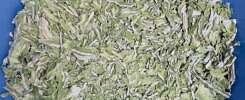Levels of Leucaena Hay and Cactus Pear in Diets for Crossbred Steers
As livestock producers, we always look for innovative and cost-effective ways to feed our cattle. One approach combines different feed sources to create a more balanced and adequate diet. In this blog post, we will explore the benefits of combining Leucaena hay (Leucaena leucocephala leucocephala) with cactus pear (Nopalea cochenilifera Salm Dyck) in the diets of crossbred steers.
The Benefits of Leucaena Hay and Cactus Pear
Leucaena hay is a high-quality forage that is rich in protein and fiber, making it an excellent feed source for cattle. It has been shown to improve growth performance, increase feed efficiency, and enhance nutrient digestibility in cattle diets.
Cactus pear, on the other hand, is a drought-tolerant plant that can be used as a supplementary feed source for cattle, particularly in arid and semi-arid regions. It is rich in water, minerals, and vitamins, making it an excellent source of hydration and nutrients for cattle.
Combining Leucaena Hay and Cactus Pear: A Nutritional Synergy
Recent research has explored the idea of combining Leucaena hay and cactus pear in the diets of crossbred steers. This combination is based on the concept of nutritional synergy, which suggests combining different feed sources can result in a more balanced and adequate diet for livestock.
The optimal combination of Leucaena hay and cactus pear can be determined by assessing the effects of different ratios on growth performance, feed efficiency, and nutrient digestibility in crossbred steers. Studies have used various ratios of Leucaena hay to cactus pear, such as 100:0, 75:25, 50:50, and 25:75, to determine the best combination for maximizing growth, health, and production.
The Results: Finding the Optimal Ratio
Research has shown that combining Leucaena hay with cactus pear can improve growth performance, increase feed efficiency, and enhance nutrient digestibility in crossbred steers. The optimal ratio of Leucaena hay to cactus pear will depend on factors such as the specific nutritional requirements of the cattle, the availability of the feed sources, and the overall goals of the livestock producer.
Generally, a higher proportion of Leucaena hay in the diet has been associated with better growth performance and feed efficiency. A higher proportion of cactus pear can provide additional hydration and nutrients. Therefore, the optimal ratio may be somewhere in the middle, such as a 50:50 or 75:25 ratio of Leucaena hay to cactus pear.
Practical Recommendations for Livestock Producers
If you are considering incorporating leucaena hay and cactus pear into the diets of your crossbred steers, it is essential to start by assessing the specific nutritional needs of your cattle and the availability of these feed sources in your region. Once you have determined the optimal ratio for your situation, you can gradually introduce the new diet to your cattle, monitoring their growth performance, feed efficiency, and overall health.
In conclusion, the combination of Leucaena hay and cactus pear in the diets of crossbred steers has the potential to improve growth, health, and production. By finding the optimal ratio of these two feed sources, livestock producers can create a more balanced and adequate diet for their cattle, ultimately enhancing the sustainability and profitability of their operations.
Pages
Categories
- Water conservation and management
- Walter Schroth
- Visitors and tourists to the Monti Iblei area of the province of Syracuse
- University
- Sustainable agriculture and farming practices
- Story
- Researchers and academics
- Recipes
- Policy and advocacy for arid regions
- Plant species and cultivation techniques suitable for arid regions
- People
- Members of the dryGrow Foundation
- ISHS
- Innovative technologies and solutions for arid regions
- Indigenous knowledge and traditions related to farming and land management
- Grazing Systems
- Grazing
- Foundation related
- Farmers and agricultural workers
- Education and outreach programs
- Contests
- Community-driven development and empowerment
- Climate change impacts and adaptations
- Carbon capturing
- Cactus World Characters
- Arid land management and conservation
- Animal Diets
Posts
- What was the trigger that prompted Walter Schroth to create dryGrow Foundation
- Donations
- X International Congress on Cactus Pear and Cochineal: 70. Control of pest cactus and cactus pests in Africa and reproduction performance of Dactylopius opuntiae
- X International Congress on Cactus Pear and Cochineal: 71. Control of pest cactus and cactus pests in Africa
- X International Congress on Cactus Pear and Cochineal: 72. Effect of tree tobacco leaf extracts on mortality rate of carmine cochineal
- X International Congress on Cactus Pear and Cochineal: 73. Dactylopius coccus Costa pest of beles, and ways for sustainable pest management and development in Tigray, Ethiopia
- X International Congress on Cactus Pear and Cochineal: 74. For an agroecological management of Dactylopius opuntiae (Hemiptera: Dactylopiidae)
- X International Congress on Cactus Pear and Cochineal: 75. Cactus – the New Green Revolution in Drylands: Functional response of the lady beetle, Hyperaspis trifurcata preying upon Dactylopius opuntiae (Hemiptera: Dactylopiidae)
- Combining Leucaena Hay and Cactus Pear for Crossbred Steers’ Diets
- How to make Nopal Flour
- The carbon-capturing potential of Opuntia species.
- Carbon Capturing Mechanisms in Opuntia
- Cactus Feeding & Rotational Grazing: A Sustainable Trend in Ranching
- Prickly Pear the drought-resistant crop
- Were we are – Monti Iblei Syracuse
- Opuntia Cactus: The Solution to Camel Herders’ Nutrition Challenge
- What is Micropropagation
- Exporting endemic Opuntia from Mexico
- Professor Paolo Inglese University of Palermo
- Unlocking the Potential of Opuntia Ficus Indica: Prof. Stefano La Malfa
- San Cono’s Secret
- The magic of the Fico d’India
- Prof. Jose Dubeux a Pioneer in Promoting Sustainable Use of Cacti
- USE of LED Lights for growing Cactus
- A Beacon of Hope for Adigrat University and Sustainable Agriculture
- Who is Djalma Cordeiro Dos Santos?
- About Orelha de Elefante Clones
- University research
- Get involved
- Biomass – Opuntia – What we do and offer
- dryGrow`s 1st Photo & Video contest (closed)
- Geographical Areas-Resources

